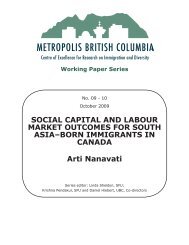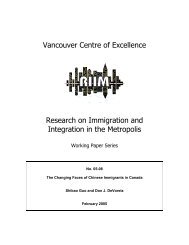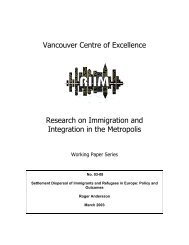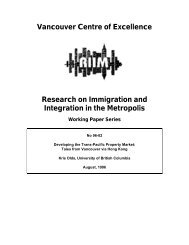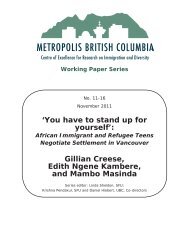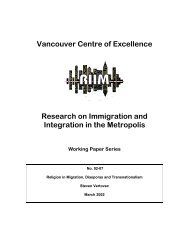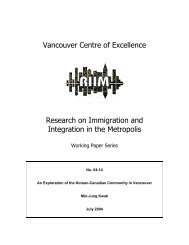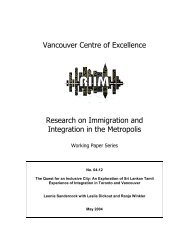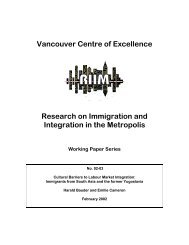Characteristics of Immigrant Transnationalism in ... - Metropolis BC
Characteristics of Immigrant Transnationalism in ... - Metropolis BC
Characteristics of Immigrant Transnationalism in ... - Metropolis BC
Create successful ePaper yourself
Turn your PDF publications into a flip-book with our unique Google optimized e-Paper software.
9<br />
transnational bus<strong>in</strong>ess ownership; aga<strong>in</strong> just under 50 <strong>of</strong> our respondents operated bus<strong>in</strong>esses <strong>in</strong> their<br />
home countries. 4 A much larger proportion own property abroad, nearly one quarter <strong>of</strong> all respondents.<br />
F<strong>in</strong>ally, on the economic front, around one <strong>in</strong> seven respondents send money to family and friends <strong>in</strong><br />
their pre-migration country.<br />
These basic data on transnationalism reveal a clear pattern already well established <strong>in</strong> the<br />
literature: there is much variation <strong>in</strong> the extent and <strong>in</strong>tensity <strong>of</strong> transnational activity. Some immigrants<br />
presumably do not participate <strong>in</strong> these sorts <strong>of</strong> <strong>in</strong>teractions at all, as they have no family or friends left<br />
<strong>in</strong> their pre-migration country. 5 Also, small numbers <strong>of</strong> our sample have friends and relatives <strong>in</strong> the<br />
home country but make no effort to stay <strong>in</strong> touch with them. There is also what we could call a middlelevel<br />
<strong>of</strong> transnationalism, with occasional visits to and fro mixed with regular electronic contact and,<br />
perhaps, some f<strong>in</strong>ancial <strong>in</strong>terests that stretch across the vast distance that separates pre- and postmigration<br />
contexts. There are also those who, no doubt, answered all, or nearly all, <strong>of</strong> our questions<br />
affirmatively—those who fit the description usually <strong>of</strong>fered <strong>of</strong> cosmopolitan transnationals, who live<br />
lives characterized by geographical fluidity and who identify themselves with at least two places. The<br />
<strong>in</strong>terest<strong>in</strong>g question, <strong>of</strong> course, is, what dist<strong>in</strong>guishes those who ma<strong>in</strong>ta<strong>in</strong> extensive transnational l<strong>in</strong>ks<br />
from those who do not<br />
In the rema<strong>in</strong>der <strong>of</strong> the tables presented <strong>in</strong> this chapter, we focus on the either/or questions<br />
posed to respondents. In each table we cross-tabulate a socio-economic or demographic feature <strong>of</strong> our<br />
sample with eight <strong>in</strong>dicators <strong>of</strong> transnationalism. Cells <strong>in</strong> each table refer to the percentage <strong>of</strong><br />
respondents <strong>in</strong> a particular category (<strong>in</strong> rows) who answered the question (<strong>in</strong> columns) positively. In<br />
construct<strong>in</strong>g these tables, chi-squared tests were conducted to identify statistically significant<br />
relationships. Note that these tests should be seen as <strong>in</strong>structive rather than def<strong>in</strong>itive <strong>in</strong> several cases<br />
where the sample size is quite small. This is particularly the case when deal<strong>in</strong>g with the questions<br />
about job-related transnational travel and transnational bus<strong>in</strong>ess ownership. Also, readers should be<br />
alert to the cases where socio-economic and demographic categories are small, and treat them with a<br />
degree <strong>of</strong> caution.<br />
The first and perhaps most important f<strong>in</strong>d<strong>in</strong>g <strong>of</strong> our study is that the relationship between level<br />
<strong>of</strong> transnationalism and socio-economic status is relatively weak. Our survey <strong>in</strong>cluded questions that<br />
4 Of course this figure must be an underestimate as most migrants with transnational bus<strong>in</strong>ess activities are<br />
overseas for most <strong>of</strong> the year, and would therefore not be at home for a telephone <strong>in</strong>terview.<br />
5 However, it is still possible that they <strong>in</strong>teract regularly with family or friends <strong>in</strong> a third country, an issue not<br />
explored <strong>in</strong> our survey.



